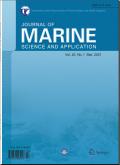半潜船波浪运动与载荷预测数值方法的比较研究
IF 2.1
4区 工程技术
Q2 ENGINEERING, MARINE
引用次数: 0
摘要
基于势流理论和/或Morison方程的数值模拟工具被广泛用于预测海上浮式风力平台的水动力响应。一般来说,这些简化的方法用于运行条件下的分析,尽管要仔细选择方法来考虑粘性效应。然而,由于水动力建模仅限于线性和弱非线性模型,这些方法严重低估了半潜器的低频非线性波浪载荷和动力响应。它们可能无法捕捉到恶劣海况下重要的非线性。为了预测半潜式船的波浪运动和载荷,本研究系统地比较了一种完全非线性的粘流求解器和一种结合势流理论和莫里森-阻力载荷的混合模型。结果表明,当非线性现象不占主导地位时,混合模型与高保真方法的结果吻合较好,而对于高度非线性的规则波,两者的差异较大。具体而言,本文研究了不同频率下不同陡度的规则波,补充了这两组方法在适用性方面的认识。本文章由计算机程序翻译,如有差异,请以英文原文为准。
Comparative Study of Numerical Methods for Predicting Wave-Induced Motions and Loads on a Semisubmersible
Abstract Numerical simulation tools based on potential-flow theory and/or Morison’s equation are widely used for predicting the hydrodynamic responses of floating offshore wind platforms. In general, these simplified approaches are used for the analysis under operational conditions, albeit with a carefully selected approach to account for viscous effects. Nevertheless, due to the limit hydrodynamic modelling to linear and weakly nonlinear models, these approaches severely underpredict the low-frequency nonlinear wave loads and dynamic responses of a semisubmersible. They may not capture important nonlinearities in severe sea states. For the prediction of wave-induced motions and loads on a semisubmersible, this work systematically compares a fully nonlinear viscous-flow solver and a hybrid model combining the potential-flow theory with Morison-drag loads in steep waves. Results show that when nonlinear phenomena are not dominant, the results obtained by the hybrid model and the high-fidelity method show reasonable agreement, while larger discrepancies occur for highly nonlinear regular waves. Specifically, regular waves with various steepness over different frequencies are focused in the present study, which supplements the understanding in applicability of these two groups of method.
求助全文
通过发布文献求助,成功后即可免费获取论文全文。
去求助
来源期刊

Journal of Marine Science and Application
ENGINEERING, MARINE-
CiteScore
3.60
自引率
5.60%
发文量
53
期刊介绍:
The aim of the Journal of Marine Science and Application (JMSA) is to provide a platform for current issues in a range of topics relevant to marine science and engineering, and to guide engineering application for scientists and engineers.
JMSA is a scholarly international journal, publishing high-level peer-reviewed research on the subjects in the field of theoretical and experimental investigations, that explore naval architecture, ocean engineering, marine renewable energy, underwater technology, marine engineering, corrosion prevention, ocean acoustics, automatic navigation among others. Topics include, but are not limited to:
Naval architecture
Marine hydrodynamics
Structural mechanics
Design methodology & practice
Ship resistance and propulsion
Safety and reliability
Marine equipment technology
Ocean engineering
Coastal engineering
Offshore engineering
Marine drilling
Pipelines and risers
Cable, mooring, buoy technology
Marine renewable energy
Offshore wind energy utilization
Ocean wave energy utilization
Ocean current energy utilization
Underwater technology
Underwater vehicles
Underwater explosion
Ocean resources & mining
Marine sensors
Marine engineering
Marine engines and fuels
Marine power engineering
Vibration and noise control
Heat transfer and fluid flow
Ocean acoustics
Sonar and transducers
Sound propagation and scattering
Acoustical oceanography
Signal coherence and fluctuation
Polar and arctic engineering
Design of ice-going ships
Arctic structures
Ice loads and simulation of ice
Marine environmental engineering
Oil spill prevention
Maine pollution modeling
Marine corrosion and protection
Corrosion and deterioration modeling
Ship corrosion protection
Pipeline corrosion protection
Automatic navigation
Ship navigation system
Marine navigation equipment
System dynamics & control
Marine science
Marine meteorology
Ocean internal waves
Extreme offshore environments
Experimental technology of above
Engineering application of above
The journal welcomes submissions of papers around the world on all the above topics. It also receives original works in the other emerging and interdisciplinary areas of the oceans.
 求助内容:
求助内容: 应助结果提醒方式:
应助结果提醒方式:


